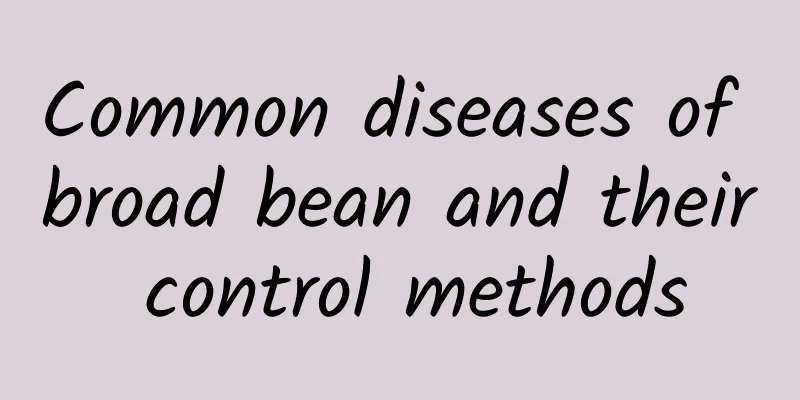Common diseases of broad bean and their control methods

|
I have planted some broad beans in my yard, but broad beans often have some insect pests. What should I do? 1. Red spot disease:Small red spots first appear on the leaves, gradually expanding into round or oval lesions. In severe cases, all parts turn black and wither and rot. There are black sclerotia on the inner wall of the stem. Chemical control: In the early stage of the disease, spray Bordeaux liquid with a ratio of 1:2:100. After that, spray 50% carbendazim 500 times liquid once every 10 days, and spray 2-3 times in a row. Practice has proved that spraying Bordeaux liquid is better than spraying carbendazim in the early stage. Spraying carbendazim later has a higher prevention effect than Bordeaux liquid. 2. Rust:Rust spots appear on the leaves until the leaves dry up. In severe cases, the whole plant dies. Chemical control: 50 grams of 15% triadimefon can be sprayed with 50-60 kilograms of water. Use 40-60 kilograms of liquid per mu. Spray once more about 20 days after application. Pay attention to timely application of the drug in the early stage, otherwise, the prevention effect will be poor. 3. Wilt:The main symptoms are blackening of the roots, short taproots, few lateral roots, yellowing of leaves, wilting of plants, and drooping of stems and leaves at the top. Chemical control: In the early stage of the disease, 500 times dilution of 50% thiophanate-methyl can be applied to the roots. Applying the drug 2-3 times has a good control effect. 4. Broad bean weevil:Coleoptera, Curculionidae. The larvae bore into the seeds of broad beans, causing them to taste bitter and lose weight, resulting in reduced yield and poor quality. Chemical control: Spray 20 ml of Sumitoxin with 60 kg of water per mu from the early to the peak flowering period of broad beans to kill the adults. Spray again after 7 days for good results. At the end of the flowering period of broad beans, spray 1000 times diluted 40% Dimethoate to kill the larvae, which also has a good effect. Broad bean, an annual herb; stems erect, hairless, 30-180 cm high. Pinnate compound leaves with 1-3 pairs of leaflets, apical tendrils not well developed and needle-shaped; stipules large, semi-arrow-shaped. Flowers 1 to several, axillary on very short peduncle; flowers white with red, with purple spots; calyx bell-shaped, calyx teeth 5, lanceolate. Pods large and fleshy; seeds oval, slightly flat. Flowering and fruiting period April-May. 5. Broad bean root rotIt is a fungal disease that prefers a hot and humid environment. It is common in Yunnan Province and usually occurs during the flowering period. It mainly harms the roots and stem base, causing the entire plant to wilt. [Symptoms]: The main roots and stem bases of the affected plants initially develop water-soaked spots, which then turn black and rot, the lateral roots wither and decay, the cortex easily falls off, and there is a dense layer of white snow on the surface of the rotten roots, which is the mycelium of the pathogen, and black particles resembling rat feces, which are the sclerotia of the pathogen. In the later stage, the moisture in the diseased stems evaporates, the diseased parts dry up and turn gray, the epidermis cracks like hemp, and sometimes there are black particles resembling rat feces inside. [Epidemic pattern]: The pathogen can survive or be transmitted on seeds, with a seed carrying rate of 1.2% to 14.2%, and is mainly transmitted on the seed surface through the seed coat. In addition, the pathogen that overwinters in the soil with mycelium and thick-walled spores along with diseased residues can become the primary source of infection the following year. The severity of the disease is related to the soil moisture content. When the groundwater level is high or the field is waterlogged, the field water holding capacity is higher than 92%, the disease is most serious, and the field with high terrain has a lighter disease; the field with intensive farming and the rotation of broad beans, wheat and rapeseed in winter has a lighter disease. The difference between years is related to meteorological conditions. In years with continuous rain during sowing, the seedlings die severely. 【Prevention and control methods】: (1) Strengthen field management. Irrigate in time during drought; drain and drain water in time during rainy season; rotate crops properly and do not apply nitrogen fertilizer excessively; plant plants at a reasonable density to ensure good ventilation and light transmission in the field, improve the disease resistance of plants and reduce diseases. When sowing, cover the seeds with 150g of 50% carbendazim per mu mixed with fine soil. (2) Chemical control. During the seedling stage, irrigate the roots with 1000 times diluted 50% carbendazim, or spray with 800-1500 times diluted 70% thiophanate, or 600 times diluted 65% mancozeb wettable powder for prevention and control. |
<<: What is Favism? Favism Diagnosis
>>: Broad bean efficacy and therapeutic effects
Recommend
Can pregnant women eat yacon? Can eating yacon help lose weight?
We often eat fruits, but I believe most people ha...
What are the health benefits of pine pollen
Pine pollen is a natural health food that has bee...
Will eating too much longan cause internal heat? What are the disadvantages of eating too much longan?
Longan is a highly nutritious fruit with a sweet ...
Dragon fruit guava juice recipe and effects
Have you ever drunk dragon fruit guava juice? It ...
How to eat Dendrobium officinale powder? How to eat Dendrobium officinale powder best?
Dendrobium officinale powder is made of the preci...
Nutritional value and benefits of pineapple berry
Pineapple berry is a particularly novel fruit bec...
How to make delicious papaya porridge? Ingredients and steps for making papaya porridge
Papaya porridge is an excellent beauty porridge. ...
What are the benefits of eating durian? What are the benefits of eating durian?
Although durian has a special fragrance and some ...
Olive oil benefits and functions
Are you familiar with the effects of olive oil? I...
The efficacy and function of Huoxuedan
Huoxuedan is a traditional Chinese medicine that ...
Purple Sweet Potato and Salmon Porridge
How much do you know about purple sweet potato and...
The efficacy and function of Orange No. 7
Have you ever eaten Orange No. 7? It is a fruit s...
What does it look like when brown sugar goes bad? Can you still drink brown sugar if it goes bad?
Many people know brown sugar. Brown sugar soaked ...
What to eat to supplement collagen? Dietary methods to supplement collagen
Many people have heard that supplementing collage...
The efficacy and contraindications of leek
[Aliases of leeks] Yellow chives, white chives, l...









